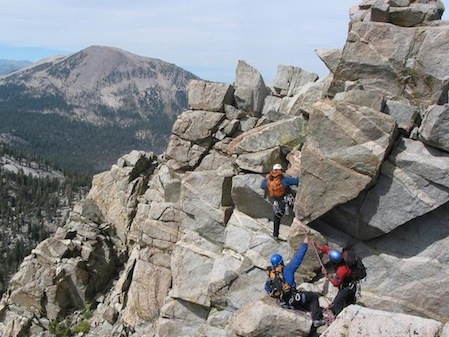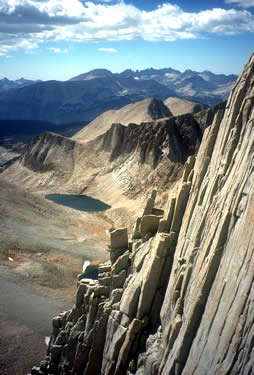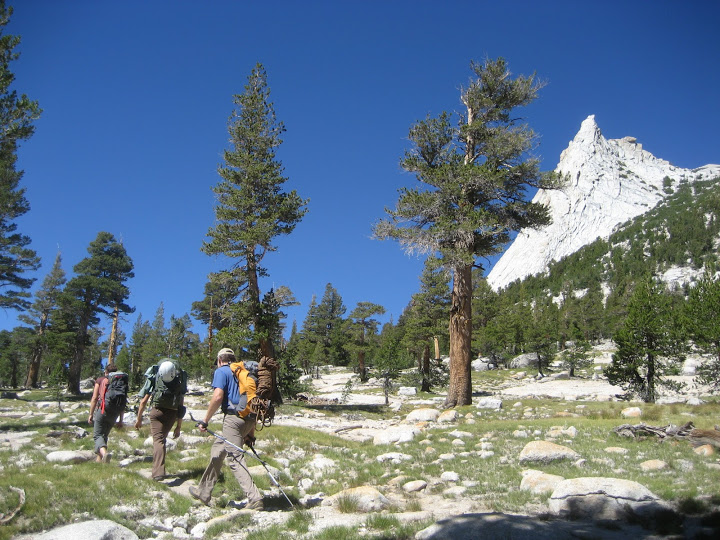Sierra Mountaineering and Technical Leadership Overview Bear Creek Spire, in the heart of the Sierra. John Tack
This trip is currently unavailable.
We currently do not run this program. Alternatively, we offer our Alpine Mountaineering and Technical Leadership Parts 1 - 4 in Washington.
If you would like to develop a full range of mountaineering skills and the ability to safely lead your own climbing teams in an alpine environment, this course is a great choice for you. Our principal goals will be to help you become qualified as a team leader in both technical skills and mountain judgment, and capable of safely leading rope teams on alpine routes at basic and intermediate levels of technical difficulty. This course can be integrated into the Alpine Mountaineering and Technical Leadership curriculum. Participants, upon request, will recieve a guide recommendation for subsequent programs to fill in their skill set before joining AMTL Part 3.
Both technical and judgment skills are taught each day, and more advanced techniques are presented as the program progresses. Each skill is demonstrated in detail and practiced thoroughly, and all are applied during the series of ascents that we make. The curriculum is also structured so that there is a steadily growing amount of attention given to the issues, responsibilities, and techniques involved in the leadership of alpine climbing teams as we move through the course.
You will be impressed by how much you take away from this program. While you don't need any climbing experience to join us, by the time you leave you should have solid climbing skills as well as a good grasp of protective systems and hazard assessment.
Goals
Our principal goal in this program is to make each participant competent as a team leader, capable of leading small groups in the alpine environment, and adequately skilled to lead rope teams on basic and intermediate alpine routes.
This goal is sought through the development of skills in four major areas: Specific alpine travel and technical climbing skills for snow, ice, and rock objective hazards evaluation mountaineering leadership skills and Leave No Trace travel and climbing skills. The twelve-day curriculum is structured so that there is a steadily growing amount of attention given to the issues, responsibilities, and techniques involved in the leadership of alpine climbing teams. Skills are taught throughout the course, and more advanced techniques are presented as the program progresses through a series of ascents.
Treatment of all aspects of the curriculum is intended to be practical and not just theoretical. While the ideas behind the course are central to the overall experience and a full understanding of alpine climbing, it is the development of the ability to apply them that makes this program exciting when taken and important for each participant's many years of mountaineering to come.
Sierra Mountaineering and Technical Leadership Structure and Curriculum We vary the setting for the program to provide the best opportunity for learning, practice climbing, and ascents. Depending on the month, weather, and conditions on the various peaks, we choose from several rock and alpine climbing crags near Bishop, CA. A typical course may use two of these areas for rock, snow, and ice climbing instruction and then follow up with two or three challenging routes on nearby Sierra classics and California fourteeners . Among the possible routes we choose from are the Swiss Arete on Mt. Sill (14,153') , the North Couloir of North Peak (12,242') , the North Ridge of Mt. Conness (12,590') , the Northeast Ridge of Bear Creek Spire (13,720') and the U-Notch Couloir on North Palisade (14,242') . Working closely with their guide each group will choose an itinerary that serves the specific goals and abilities of participants and best achieves the objectives of the course.
Leading in the alpine requires a variety of important skills. Andrew Yasso
Curriculum
Alpine Travel and Climbing Skills
Selection and use of technical equipment for rock, snow, and ice climbing
Wilderness navigation
Climbing techniques for low and high angle rock, snow, and ice
Belaying on rock, snow, and ice
Risk management and efficiency for travel on technical terrain
Crampon and ice axe techniques including self arrest and self belay
Descent strategies and decision making
Objective Hazards Evaluation and Self-Rescue Skills
Evaluation and prediction of mountain weather patterns
Evaluation and prediction of rockfall patterns
Survival techniques and bivouacs
Leadership Skills
Technical and personal functions of individuals in the rope team; role and responsibility
Problem solving: assessment techniques and processes in subjective decision making
Evolving leadership roles: individual leadership vs. collective decision making
Recognizing and developing appropriate response to changing mountain conditions
Environmental Protection Skills
An introduction to alpine ecology
Leave No Trace travel, camping, and climbing skills
Sierra Mountaineering and Technical Leadership Dates Striking a pose on the summit of Mt. Conness after climbing the wild North Ridge. Andy Bourne
This course has been reformatted into Alpine Rock 1 and Alpine Rock 2 courses and designed to fit within the framework of our Alpine Mountaineering and Technical Leadership (AMTL) series.
You may also choose to complete the SMTL curriculum privately.
Alpinism 1 + Alpine Rock 1 = AMTL 1
Alpinism 1 + Alpine Rock 1 and Alpine Rock 2 + Alpine Ice = AMTL 1 and 2
Sierra Mountaineering and Technical Leadership Cost and Details Prerequisites
Backpacking experience
Good physical fitness
Program Costs: Inclusions and Exclusions
Inclusions:
Guide fees
All group technical climbing equipment
Permit and access fees
Exclusions:
Personal equipment such as clothing, boots, personal climbing gear (e.g., harness, helmet), sleeping bag, tent, etc. Personal climbing and camping gear is available for rent at a nominal charge.
Transportation to the program's meeting location and during the program. We ask that you provide transportation for your guide from the point of rendezvous, and if there are other climbers in your program we encourage you to carpool.
Lodging costs (if any)
Meals
Fees for changing air itineraries because of canceled or delayed programs
Gratuities to guides
Personal health, baggage, and trip cancellation insurance
Rental Equipment
For beginners and other climbers who do not have their own personal climbing equipment, we offer rental equipment. The following items are available to rent in the Sierra:
helmets
harnesses
ice axes
crampons
ice tools
tents
avalanche gear (beacon/probe/shovel)
cooking gear (stove/pot/fuel)
snowshoes
backpacks
Please note that we do not rent boots, sleeping bags or sleeping pads in the Sierra; your best option if you need this gear for your course is to contact Wilson's East Side Sports in Bishop, CA, or Mammoth Mountaineering in Mammoth Lakes, CA. Regardless of what you need, please be sure to alert all parties of your rental needs as soon as possible.
Sierra Mountaineering and Technical Leadership Related Courses
Program Finder
By Location
United States - Alaska
United States - Washington
United States - California
United States - Nevada
United States - Colorado
United States - Utah
Canada - British Columbia
South America - Argentina
South America - Bolivia
South America - Ecuador
South America - Patagonia
South America - Peru
Europe - Alps and Caucasus
Asia - Nepal and Tibet
Asia - Laos, Thailand, & Vietnam
Asia - China
Asia - Japan
Africa - Tanzania
Pacific and Antarctica
By Program Type
Instructional Courses
Group Summit Climbs
Expeditions
Skills Expeditions
Private Guided Programs
Treks, Tours, & Backpacking
Corporate Outings & Services
Government & Military
By Activity
Rock Climbing
Ice Climbing
Alpine Climbing
High-Altitude Climbing
Trekking and Backpacking
Skiing & Snowboarding
Guide Training & Rescue
Avalanche Training
Departure Month
Difficulty Level
Beginner
Moderate
Intermediate
Advanced
Very Advanced
x





